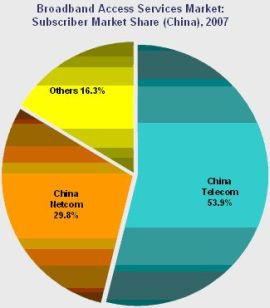The broadband that connects China

The Chinese population is highly connected, especially since China is home to the largest number of broadband subscribers in the Asia-Pacific region.
Khoo Yong Lih, senior industry analyst at Frost & Sullivan, said there were 66.4 million broadband subscribers in China as of the end-2007. This represented a 28.1 percent year-on-year growth, Khoo told ZDNet Asia in an e-mail interview, adding that the household broadband penetration rate was 14.8 percent.
At the same time, the number of narrowband (dial-up) subscribers fell 26.1 percent over the same period to 19.5 million, which resulted in a narrowband-to-broadband subscriber ratio of 1 to 3.4.
According to Khoo, China's broadband revenues rose 35.7 percent year-on-year to US$6.4 billion in 2007, generating an ARPU (average revenue per user) of US$9.80 for service providers.
 Source: Frost & Sullivan |
Broadband's strong showing in China is mainly driven by the popularity of video content-sharing services, social networking, locally-developed multiplayer online games, video-on-demand services offering hundreds of local titles, and the introduction of lower cost IP (Internet Protocol) phone services, he said.
In addition, service providers have engaged in some aggressive marketing, such as bundling fixed-line with broadband services, and introducing innovative broadband value-added services related to the 2008 Beijing Olympic Games, including the "Olympic Channel" and "Olympic Yellow Pages".
Young, rural Netizens
Cynthia Leung, senior analyst at Ovum, said the rise of China's "new Netizen" population in 2007 was relatively significant among two age groups--those aged below 18 years, and above 30.
"The number of Netizens with secondary school education, and below, has grown fast, and low-income groups have started to accept the Internet increasingly," Leung said in an e-mail interview. "Rural groups accessing the Internet also grew relatively fast."
Khoo said China's "Internet Connection for Every Village" initiative, introduced by the regulator in 2006, has seen significant results. "According to China's Ministry of Industry and Information Technology, about 97 percent of villages nationwide are able to access Internet services today."
The provinces and municipalities at China's coastal region, such as Shanghai, Jiangsu, Zhejiang, Fujian, Guangdong, Shandong, Liaoning and Henan, accounted for half of the total broadband subscribers in China last year, said Khoo. The analyst attributed this to strong economic growth zones, higher PC penetration, wider broadband network coverage, and better income per capita in these areas, compared to the western parts of China.
Leung said, on average, a Chinese family spends 74.9 yuan (US$11) per month on Internet access, while annually, it is 900 yuan (US$132) per family. The average expense incurred by a Netizen who surfs at the Internet cafe is RMB51.6 (US$8) per month.
"Since China's per capita income is not so high yet, online surfing has not become a 'popular consumption'. With the surfing cost cut further, it is foreseeable that more residents will surf online," he said.
(as at end-2007)
• 210 million (73 million new users in 2007)
Access breakdown
• 19.49 million dial-up (6.95 million fewer subscribers than in 2006)
• 66.46 million broadband subscribers
(a rise of 15.61 million over 2006)
Infrastructure
• 8.54 million installed broadband access points
According to Leung, DSL (digital subscriber line) technology started its predominance as a broadband access technology in China in 2003, as a result of aggressive promotions by fixed-line operators through data rate reductions and service expansions.
"Given the dominance of fixed-line operators, DSL remains the leading broadband technology, accounting for over 70 percent of broadband connections," she said.
Meanwhile, FTTH (fiber-to-the-home) access, which was introduced in China in 2004, has also caught the attention of broadband subscribers in the country.
Khoo said the number of FTTH subscribers reached 14.3 million in 2007, accounting for 21.5 percent of China's total broadband subscribers. He added that broadband providers have aggressively deployed this full optical fiber network infrastructure, especially in the cities hosting the 2008 Beijing Olympics events.
"Due to [DSL] copper's bandwidth constraint, optical fiber connection [offered on FTTH] with the capability of providing higher speeds of 100Mbps (Megabits per second) or more, is expected to become more popular in China in the next three to four years," Khoo said.
FTTH could get a further boost from the increasing popularity of IPTV, which consumes high bandwidths of 10Mbps or more.
"As at May 2008, there were 943,600 IPTV subscribers across 12 provinces/municipalities, and Shanghai alone accounts for 53 percent of China's IPTV subscribers," Khoo said.